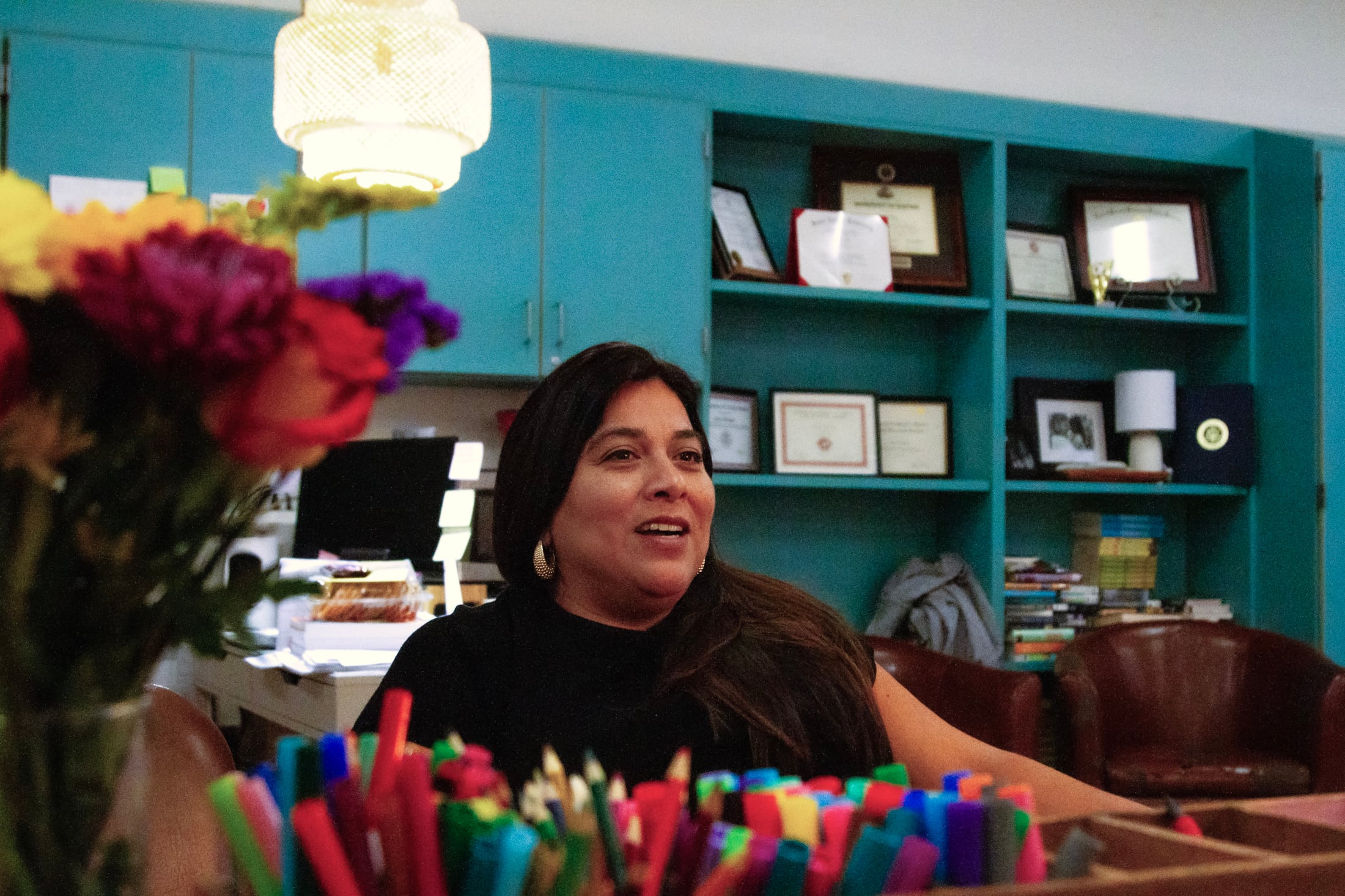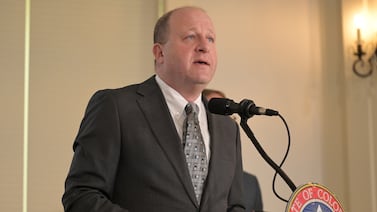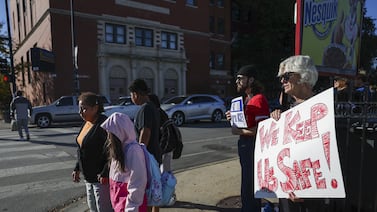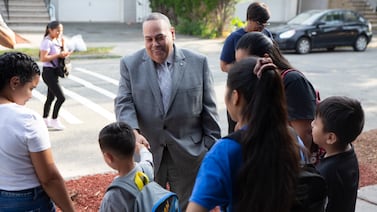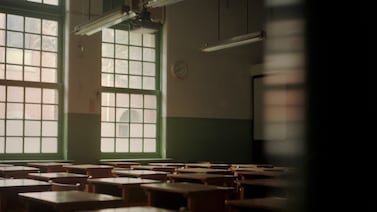Sign up for Chalkbeat Indiana’s free daily newsletter to keep up with Indianapolis Public Schools, Marion County’s township districts, and statewide education news.
This article was originally published by Mirror Indy.
Graciela Miranda’s corner of Pike High School feels more like a cozy coffee shop than it does a classroom.
Blankets are draped across the worn leather chairs that students gravitate to between classes. Reading recommendations fill in the back whiteboard, and boxes of books — new selections to fill the shelves of Miranda’s classroom library — line the back wall.
It’s a space the 23-year educator has purposefully created to appeal to her students. She knows from her time volunteering in schools in South America the value of readily available books and a space that helps students find their joy in learning.
But for Leandra Rodríguez, a senior at Pike High School, it’s more than just the books and bean bag chairs that keep her visiting Room H115. It’s the connections that Mrs. Miranda makes with students.
“She is always helping,” Rodríguez said. “She’s like our mom.”
Earning the trust of teenagers is hard enough. But Miranda, who teaches English language learners, has created a space that’s safe for students whether or not they’re on her class roster. She’s also created an environment where students look out for each other — no matter if they’re new to the country, still learning how to speak English or simply needing another adult to lean on who feels like family.
Miranda uses her own experiences as the daughter of Mexican immigrants to inform her teaching and was recently named Indiana’s Teacher of the Year. In addition to teaching, Miranda is also a department chair at Pike and advises the school’s LatinX Student Association.
Her voice stands out among Indiana teachers at a time when the Hispanic and Latino student population in Indiana largely outnumbers the educators in schools available to work with them. One in four Marion County students identify as Hispanic, according to state data provided to the Richard M. Fairbanks Foundation, compared to just 3% of teachers.
Miranda, who contributes to a Teach Indy group looking to grow diversity in the county’s teacher ranks, understands the importance of representation in schools.
“Diversity brings different ideas, different angles, the background knowledge that maybe we just don’t know,” Miranda said. “It just builds a better community.”
And part of building that community means showing up for students like Rodríguez, who is an English language learner. Though Rodríguez doesn’t have Miranda as a teacher this year, she still finds herself returning to those worn leather seats in the back of Mrs. Miranda’s room.
Miranda helps newcomers navigate school
At Pike High School, Miranda works with newcomers — immigrant or refugee children who come to the school with limited English language skills. Miranda’s classroom is made up of kids from six different countries with first languages ranging from Spanish to Haitian Creole to Gujarati, a language native to western India.
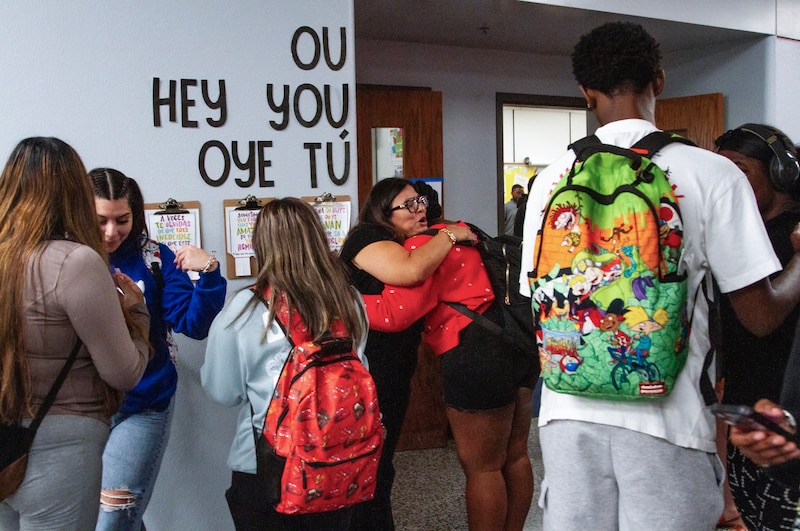
Miranda doesn’t speak all of those languages, but she does know the importance of building support systems for her students. After all, they’re not just learning a new school or new language. They’re also learning how to live in an entirely new country.
In her “sheltered” English classes, students get to know Miranda as well as their fellow classmates.
The sheltered class is one of several English, math, and science courses offered by Pike to expose newcomers to grade-appropriate lessons in a supportive learning environment.
In sheltered English, for example, students study literary works similar to other classes, but Miranda slows down her lessons to ensure students have the time they need to understand the meaning behind what’s being asked of them. She also helps her kids learn technology new to them and navigate the customs of a new school — things students in Pike’s other English classes already know well.
In a recent lesson about Mexican American author Sandra Cisneros’ novel “The House on Mango Street,” Miranda guided students through a discussion of the book’s themes. She asked students to research Cisneros’ motivations for writing her book, but also gave gentle reminders.
“You probably have to go to Google and do your research,” Miranda told her students. “Who is Sandra Cisneros? You have to use your resources.”
She tries to pick books that teach her students how to be better thinkers and that connect with their life goals. Many of her students see themselves opening a small business, so Miranda sought out the book “Atomic Habits: An Easy & Proven Way to Build Good Habits & Break Bad Ones” by James Clear to teach students the characteristics of leadership.
She also encourages reading for fun — allowing students to pick their own books for the first 10 minutes of class, including graphic novels, twisted fairytales and a recent addition to the class library, Trevor Noah’s autobiography, “Born a Crime.”
“A lot of our students haven’t had access to books,” Miranda said. “I want them to become comfortable with books. I want them just to enjoy reading a book. Nothing on the computer, just having something physical and tangible to be like, ‘Here’s a book. I like it. I can get lost in it.’”
Teaching from experience as a first-generation college student
Miranda is well suited to work with these students, because she’s walked a similar path. She was raised in a predominantly Latino community in a northwest Chicago suburb. Though her parents moved to Illinois in their teens, English was Miranda’s second language.
She still remembers riding a bus across town to attend a school that didn’t resemble her in “any way, shape or form.” She said she only encountered one Latino teacher and one Latino counselor in her high school. Miranda learned to code switch, presenting herself differently based on who she was around at school.
Self-doubt crept in. She said she didn’t fully grasp what it meant to be Latina until she reached college, and wonders whether she would’ve experienced the same self-doubt had she encountered more Latino teachers earlier in her education.
“I wonder if my thought process would’ve been different, if I would have felt validated in a different way,” Miranda said.
She now sees the opportunity to be that teacher for her students. She teaches a credit retrieval class, knowing transcripts or class completions from students’ home countries may not directly translate to what’s required of them in an Indiana school. And, she encourages her students to think early about college — something that once felt out of her own reach as a first-generation college student. It’s something she hears from her students, too.
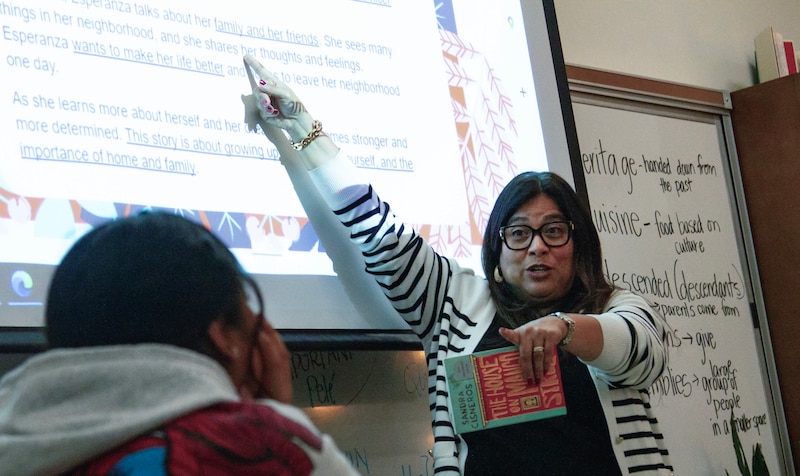
“It’s a financial thing. It’s a language thing. It’s a ‘that fate is not for me, I’m not a citizen’ thing,” Miranda said. “There’s just a lot of, ‘I can’t see myself there. It’s such a far away dream.’”
Miranda hopes that she can be an example for those students. She found her way to college and shows students how they can, too.
Teacher shows students ‘mirror image’ of themselves in college
The teacher throws a cookout every year for her seniors to celebrate graduation, and takes students to events like Somos Ivy Tech, which features a diverse panel of students enrolled at the school to help her high schoolers envision themselves on campus.
Living in dorms, for example, is something not all newcomers and their families might be comfortable with. But, talking to students firsthand about their experiences can alleviate some of their worries.
“I want them to go to campus and walk,” Miranda said. “I want them to go and hear from maybe the Latino or Asian or Indian or Haitian groups — whoever they can identify with. I want them to see a mirror image of who they can be.”
And Miranda wants to be that example for her students, using lessons she’s learned through her career of teaching for 10 years in Illinois before spending the last 14 in Pike Township as an elementary teacher, an instructional coach, a reading specialist, and now high school department chair.
Last year, she helped students launch Pike’s own LatinX Student Association, which plans events for Hispanic Heritage Month and organizes a schoolwide futsal tournament so popular the club had to close registration early its first year.
It quickly became one of senior Ayomide Fapese’s favorite activities.
Fapese isn’t a newcomer, but he sought Miranda’s help with his English studies. He’s also on the soccer team and was excited for his recent senior night — a time for families to walk with their students across Pike’s home field during their last season on the team.
But ahead of the celebration, Fapese opened up to Miranda. He wasn’t sure if his family could make it.
“I told her my parents were going to be busy,” Fapese said. “She was just like ‘I got you!’”
Fapese was all smiles as Miranda and a teammate walked with him.
The senior is now applying for scholarships and hopes to study business at Marian University or IU Bloomington. He said he appreciates that Miranda takes time to really listen to students like him.
“She understands,” Fapese said. “Whatever you need, she’s the right person to go to.”
Teach Indy aims to increase diversity
Miranda’s recent accolade, being named Indiana’s Teacher of the Year, speaks to something greater, Teach Indy executive director Sara Marshall said.
“It actually almost makes me cry every time I think about it,” said Marshall, who is Mexican American. “It signals to our students and our families and those that share the Latino identity that we are seen and we are respected.”
As an education nonprofit that seeks to build diversity in Marion County’s teaching ranks, Teach Indy wants to help close the gap between the city’s growing Latino student population and its teachers.
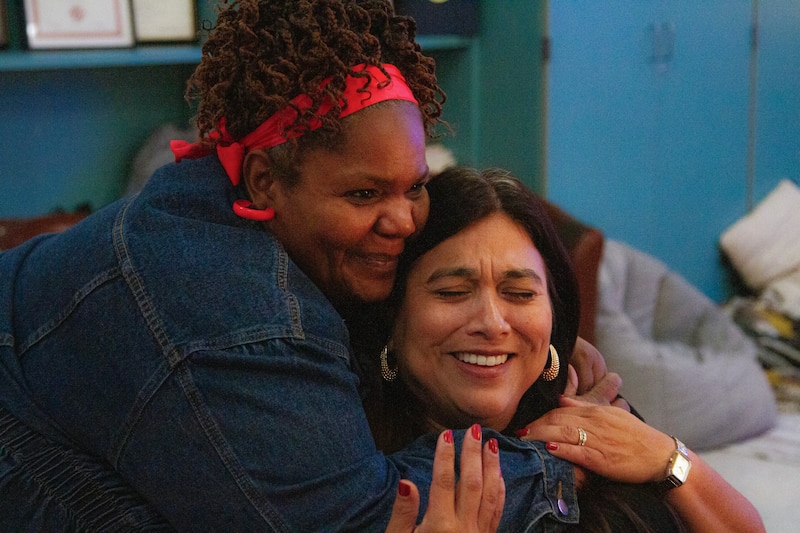
Teach Indy is partnering with Kansas City-based nonprofit, Latinx Educators Collaborative, to explore how best to support Latino teachers to grow educator retention and recruitment. Marshall says there’s a need for more mentorship opportunities for early career Latino teachers, and a greater willingness for universities and scholarship organizations to support prospective teachers, regardless of documentation status.
More Latino educators in classrooms benefits all students, Marshall said. Studies show that kids with exposure to more diverse voices ultimately feel more respected and perform better academically, which can have a lasting impact on a person’s salary and life expectancy.
Beyond that, Marshall said, it’s just good for kids to see themselves reflected in the people around them.
“What I hope people will see from this story,” Marshall said, “is the power of one educator and the ripple effect that that has across a school, across a community.”
In Pike High School, Miranda’s influence spills out into the hallway. During the passing period, students who stop into Miranda’s room first cross in front of three clipboards, each with advice and affirmations written across pull tabs in three different languages.
Messages like “Be strong enough to let go and wise enough to wait for what you deserve” were written by students and meant to take and share. Most of the time, Miranda says, students don’t take them for themselves. They give them to friends, spreading positivity through the school.
“Sometimes you forget you’re amazing,” Miranda said. “So, this is their reminder.”
Mirror Indy reporter Carley Lanich covers early childhood and K-12 education. Contact her at carley.lanich@mirrorindy.org or follow her on X @carleylanich.

